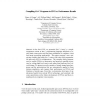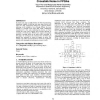ISCAS
1999
IEEE
14 years 7 months ago
1999
IEEE
An FPGA-based reconfigurable system may contain boards of FPGAs which are reconfigured for different applications and must work correctly. This paper presents a novel approach for...
ICVS
2001
Springer
14 years 7 months ago
2001
Springer
Abstract. At the first ICVS, we presented SA-C (“sassy”), a singleassignment variant of the C programming language designed to exploit both coarse-grain and fine-grain parallel...
DAC
2009
ACM
14 years 7 months ago
2009
ACM
Stream processing represents an important class of applications that spans telecommunications, multimedia and the Internet. The implementation of streaming programs in FPGAs has a...
DATE
2002
IEEE
14 years 8 months ago
2002
IEEE
The argument against ASIC SoCs is that they have always taken too long and cost too much to design. As new process technologies come on line, the issue of inflexible, unyielding d...
DATE
2002
IEEE
14 years 8 months ago
2002
IEEE
Future networked appliances should be able to download new services or upgrades from the network and execute them locally. This flexibility is typically achieved by processors tha...
FPL
2003
Springer
14 years 8 months ago
2003
Springer
The use of FPGAs for cryptographic applications is highly attractive for a variety of reasons but at the same time there are many open issues related to the general security of FPG...
DAC
2003
ACM
14 years 8 months ago
2003
ACM
In recent years, due to rapid advances in VLSI manufacturing technology capable of packing more and more devices and wires on a chip, crosstalk has emerged as a serious problem af...
FPGA
2004
ACM
14 years 8 months ago
2004
ACM
The speedup over a microprocessor that can be achieved by implementing some programs on an FPGA has been extensively reported. This paper presents an analysis, both quantitative a...
FPGA
2005
ACM
14 years 8 months ago
2005
ACM
Creating a new FPGA is a challenging undertaking because of the significant effort that must be spent on circuit design, layout and verification. It currently takes approximately ...
ICPADS
2006
IEEE
14 years 9 months ago
2006
IEEE
—Recently, high-end reconfigurable computing systems that employ Field-Programmable Gate Arrays (FPGAs) as hardware accelerators for general-purpose processors have been built. T...






